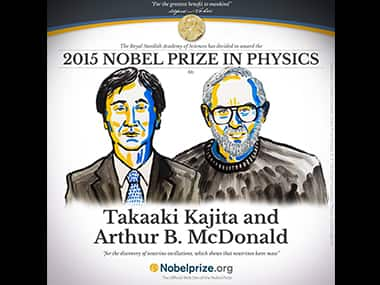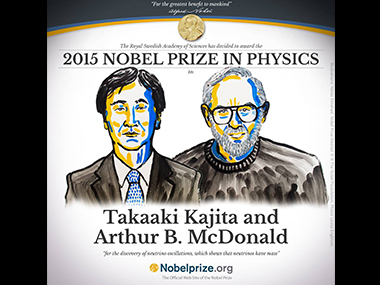Takaaki Kajita of Japan and Arthur McDonald of Canada were awarded the Nobel Prize for Physics on Tuesday for the discovery of neutrino oscillations. The pair were honoured for work that helped determine that neutrinos have mass, the Royal Swedish Academy of Sciences said. [caption id=“attachment_2457542” align=“alignleft” width=“380”]  Image courtesy: Nobel Prize Facebook page[/caption] Kajita and McDonald will share the eight million Swedish kronor (around $950,000 or 855,000 euros) prize. Who are they? Japanese physicist Kajita, 56, is the director of the Institute for Cosmic Ray Research and professor at the University of Tokyo. He is the second Nobel physics prize winner from the same research team, led by his teacher Masatoshi Koshiba who won the prize in 2002. Canadian physicist McDonald, 72, is Professor Emeritus at Queen’s University, Kingston, Canada. Asked how he felt when he realised Tuesday that his work was suddenly going to receive the world’s focus, McDonald said, “It’s a very daunting experience, needless to say.” Their work: Kajita and McDonald were cited for discovering neutrino oscillation, the process by which the subatomic particles switch between two identities, or forms. This insight proved that neutrinos, the second-most numerous particles in the universe after photons, must have mass. Neutrinos are lightweight neutral particles that are created as the result of nuclear reactions, such as the process that makes the Sun shine. Next to particles of light called photons, they are the most abundant particles in the Universe. Their existence was tentatively proposed in 1930, but was only proved in the 1950s, when nuclear reactors began to produce streams of the particles. The prevalent theory was that neutrinos were massless, but experiments carried out separately by teams led by Kajita in Japan and McDonald in Canada showed that this was not the case. Many neutrinos blasted out from the Sun — a type called electron neutrinos — and “oscillated” en route to become cousin particles called muon-neutrinos and tau-neutrinos, they found. Under the quirky rules of quantum physics, the identity change can only happen if the neutrinos have mass. Significance of their discovery: The Nobel committee said their discovery “has changed our understanding of the innermost workings of matter and can prove crucial to our view of the universe.” “This is of groundbreaking importance for particle physics and for our understanding of the Universe,” the committee added. “The experiments have… revealed the first apparent crack in the Standard Model. It has become obvious that the Standard Model cannot be the complete theory of how the fundamental constituents of the Universe function.” Intense activity is underway worldwide in order to understand more about the elusive particles. “New discoveries about their deepest secrets are expected to change our current understanding of the history, structure and future fate of the Universe,” the jury said. What the experts said: Antonio Ereditato, a neutrino expert and director of the Albert Einstein Center for Fundamental Physics at the University of Bern, Switzerland, called the award “a great day for our field.” Ereditato said the idea that neutrinos could transform from one type into another was first put forward in the late 1950s, but scientists’ understanding of the process was rather vague until Kajita’s announced his discovery in 1998. Reona Esaki, who was awarded Nobel physics in 1973, praised Kajita’s achievement, saying it was a “well-deserved” honor. “Mr. Kajita achieved a long-cherished dream of all human beings to understand the basics of the universe,” he said. Professor Barbro Asman says the discovery made by the 2015 Nobel Prize physics laureates will fundamentally change the scorebooks in physics and could help explain human existence and the origin of the universe. With inputs from agencies.
Takaaki Kajita of Japan and Arthur McDonald of Canada won the Nobel Prize in Physics on Tuesday for the discovery of neutrino oscillations.
Advertisement
End of Article


)

)
)
)
)
)
)
)
)



